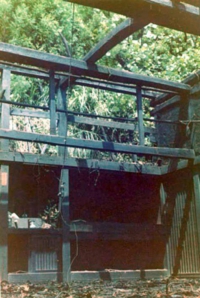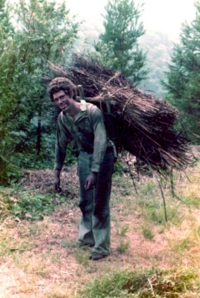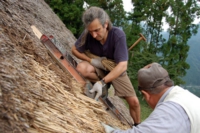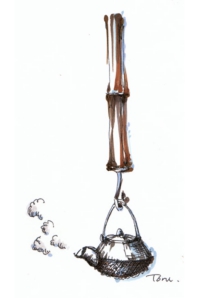![]()
初期のころ
1973年の購入当時、篪庵はかなり痛んでいました。電気・水道もなく、最後の屋根葺きから50年近く経っていて、屋根は腐敗が進み雨漏りもしていました。アレックスはまだ大学生でしたが、毎年夏には友人(南 相吉やTom Barron)と共に篪庵に赴き、1975年には古茅を使って屋根の葺き替えをしました。
1977年、アレックスは大学卒業後京都の亀岡に移住しました。そこで、外国人向けの伝統芸能研修プログラムを行っている大本教を手伝うことになりました。亀岡に住むようになると、祖谷を頻繁に訪れることが可能になり、夏休みや正月は、Diane Barracloughなどの新しい友人達も交えて篪庵で過ごしました。
当時、 篪庵ではいろいろな行事が催されました。座敷に銀箔を振りまいて能を上演したり、舞踏家である相吉の妻が踊りを披露したりしました。
1986年、屋根の総葺き替え
古い茅を使って修理したため、屋根は再び劣化しはじめました。1980年からアレックスは茅、竹、その他の材料を集め始め、今度は全体的な修理をすることにしました。喜多聡が中心になり、尾茂さんと一緒に、新しい垂木99本を切り出し家まで運びました。その後も村人たちや友人たちの助けを借りて作業を続け、1986年に総葺き替え替が完了しました。
しかし、その後アレックスは篪庵を定期的に訪れることができず、長い間人が住んでいない時期がありました。茅葺き屋根の家とって、これは深刻な問題です。囲炉裏の煙は屋根を乾燥し、害虫を遠ざけ、家を守ります。よく燻された屋根裏は、まるでワックスを塗ったように黒光りもします。
茅葺き屋根は本来70年持つとも言われます。しかし、篪庵には定住する人がいないので、再び家は急速に朽ち始めました。
コミュニティを作る
1986年から1997年の間、多くの人々が篪庵を訪れましたが、継続的に家を管理する体制は整っていませんでした。1997年、アレックスは写真家Mason Florenceと共に家の管理をすることに決め、篪庵に常時滞在するボランティアを迎えることにしました。最初のボランティアはChris and Lauren Shannonでした。
そして毎夜のように囲炉裏を囲んで話し合いをして、1999年には、“The Chiiori Project” (TCP)を発足させました。これが家に生気を吹き込み、後に篪庵トラストへと発展する芽となりました。新しいボランティア組織の出発を祝った夜には、マレーシアから訪れた舞踊家 Zulkifli Mohamedが、座敷で村の人びとに舞いを披露しました。
それからというもの、たくさんのボランティアが篪庵で生活しました。
Chris と Laurenの後、Shea Ingramが参加、今でも篪庵トラストの役員を勤めています。2001〜2004年の間は片山裕喜 と Ginevraが、2004~2007年の間はBo Zhang と Wayne Trickettが家を管理してきました。ここで暮らしたボランティアは数多く、名前を挙げきれないほどです。2005年、The Chiiori Project はNPO法人(特定非営利活動法人)として徳島県に登録されました。そして2007年、MasonがTCPから離れたので、アレックスが活動の指揮を取ることとなります。名称も「篪庵トラスト」に変更し、新しい役員とともに再編成しました。
2007年からはPaul Cato が、さらに2008年からは村松享が篪庵トラストの現地スタッフとして参加しています。
これまで、大勢の人びとが篪庵のため、貴重な時間と力をかしてくれました。今度はこの新しい篪庵トラストが彼らの夢を実現する時です。
家の維持
現在、祖谷の中で篪庵は大変ユニークな存在となっています。アレックスが最初に祖谷に足を踏み入れた1971年、多くの家はまだ囲炉裏で火を起こしていました。しかし、今は囲炉裏で火をおこす家は篪庵が最後となりました。畳を敷かない板張りの床。天井のないむき出しの垂木。篪庵は、数百年を遡る生活様式を今に伝える貴重な遺産です。江戸時代、すでに祖谷の民家は神秘の時代の産物とされ、阿波藩の大名はこの地域を「阿州之桃源郷也」と云ったと伝えられています。
篪庵を保存することは、この古い生活様式を保存、伝承することに繋がります。そのためには出来るだけ早く屋根の葺き替えと構造の修理を行う必要があります。
同時に、21世紀を生き抜くためには祖谷も前進しなければなりません。そのために篪庵トラストは活動範囲を古民家篪庵だけにとどめることなく、村全体に広げます。有機農業、空き家の利用・活用、持続可能な観光産業、自然と伝統的生活を体験するプログラムなどです。
![]()
Early Years
In 1973 the house was in poor condition. There was no electricity or running water, and nearly fifty years after the most recent thatching, the roof had rotted badly and was leaking. Alex was still in college, but used to go up in summers with friends (including Shokichi and Tom Barron), and in the summer of 1975, everyone got together and thatched the roof.
In 1977, Alex finished university and started living in Kameoka and working at Oomoto Foundation 大本 in Kameoka, a town just west of Kyoto, running their program introducing traditional Japanese arts to foreigners. From his base in Kameoka, Alex could come more regularly to Iya. A new group of friends started visiting, including Diane Barraclough, who would spend summers, vacations, and New Years Eve at Chiiori.
The house witnessed many unusual events and performances during this time, such as a Noh drama performed with silver dust sprinkled on the zashiki floors; and an evening when Shokichi’s wife (a butoh performer) danced right out of the house at midnight and into the snow.
The Full Rethatching of 1986
The roof, having been only partially repaired with used thatch, began to deteriorate. Starting in 1980, Alex began collecting thatch, bamboo, and other materials, and in 1986, the roof underwent its second, and this time a full re-thatching and renovation. Kita Satoshi 喜多 聡 acted as contractor, and he and Omo-san together felled and carried to the house 99 cedar logs which they used to replace the rotted taruki (upper rafters). Later, other friends gathered to help Satoshi and Omo-san conduct the re-thatching, which was completed in spring 1986.
Unfortunately, this was followed by a long period during which Alex was unable to visit the house regularly and there was nobody living there full time. This is a serious problem for a thatched-roofed house. With the irori burning every day, the smoke rises up and dries and cures the thatch. Insects, snakes, and other animals stay away, and the thatch, covered by soot, becomes resistant to rot. With the irori burning regularly, the thatch can last up to seventy years. However, nobody was living full-time at Chiiori so the house began to decay again.
Creating a Community
During the years 1986~1997, many people visited the house, but there was no system in place to ensure its regular upkeep. In 1997 Alex joined with Mason Florence in managing the house, following which full-time housekeepers came as volunteers to look after Chiiori. Among the first were Chris and Lauren Shannon.
After many a late night discussion, in 1999, we got together and founded “The Chiiori Project” (TCP). Charged with bringing life back to the house, this was the seed from which later grew Chiiori Trust. Zulkifli Mohamed, a dancer from Malaysia, performed in the zashiki, while the villagers watched, to inaugurate the new volunteer organization.
From that time many volunteers have lived at Chiiori. Following Chris and Lauren came Shea Ingram, who is still an advisor and director to the Trust. Katayama Yuki 片山 裕喜 and Ginevra House lived at Chiiori 2001~2004, and Bo Zhang and Wayne Trickett 2004~2007. There were many others, too many to mention.
In 2005, The Chiiori Project was incorporated officially with Tokushima Prefecture as a Japanese NPO (non-profit organization). In 2007, Mason resigned from the Trust, and Alex took over once more in an active role. The NPO was reorganized with a new board of directors, and renamed Chiiori Trust.
Since Dec 2007 Paul Cato has lived at Chiiori as on-site manager, joined in May 2008 by Toru Muramatsu.
Many people have dedicated much energy and large parts of their lives to Chiiori. As we enter the decade of 2010, it's time for the new Chiiori Trust to make their dreams come true.
Preservation
As a house, Chiiori is today unique in Iya. When Alex first entered Iya in 1971, many homes still burned fires in their irori. Today, Chiiori is the last. In many respects (the use of bare wooden floorboards, without coverings or tatami, the open rafters without ceilings), Chiiori is a precious heritage of a lifestyle that dates back thousands of years. Even in the Edo Period, Iya’s houses already belonged to a mythical era, and the Lord of Awa once described this region as “Awa’s Shangri-la”.
Preserving Chiiori is to preserve a touchstone to this ancient era. To do so, we must repair the structure and re-thatch the roof as soon as possible.
At the same time, it’s important for Iya to move on in order to survive in the 21st century. In order for this to happen, Chiiori Trust will need to expand beyond Chiiori, into the village at large. This will involve organic agriculture, restoration of old houses, building of new houses as resorts and vacation homes, sustainable tourism, and programs for people to experience nature and traditional culture in the mountains.








 alex-kerr ...
alex-kerr ...